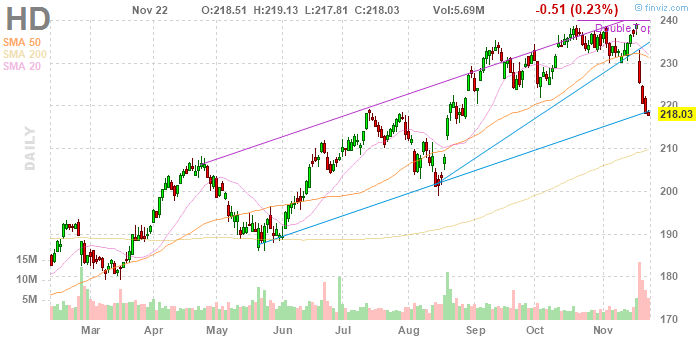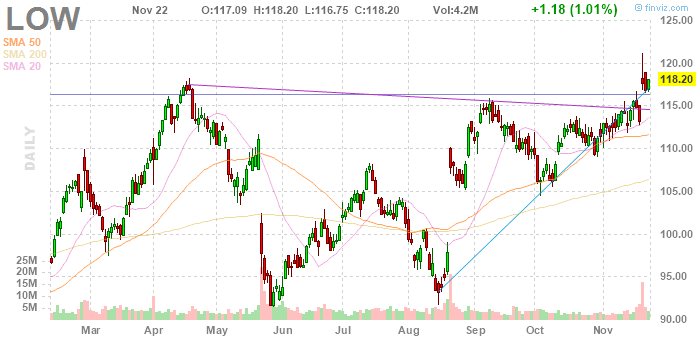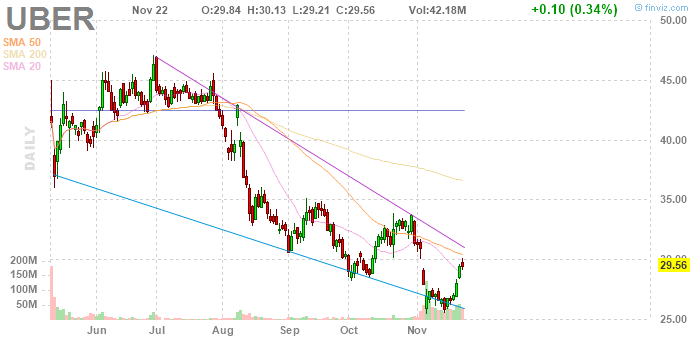Major market indices closed down modestly last week, a brief pause in an upward climb. But U.S. stocks still are heading in the right direction: the S&P 500 has gained 7.5% in less than seven weeks.
That said, the rally in recent weeks, and even recent years, hasn’t necessarily been broad-based. For most of this bull market, growth stocks have outperformed their value counterparts, though that trend has started to reverse of late. In fact, many high-multiple stocks and sectors — among them cannabis names — have struggled or outright plunged at different points this year. Meanwhile, cheaper value stocks and/or cyclical stocks have shown strength of late.
Monday’s three big stock charts highlight two stocks from a category that has been torrid in 2019, and another that has been downright awful. Though these three charts don’t make a trend, they do suggest at least a possibility that the two groups are headed for a reversal.
Home Depot (HD)
Home Depot (NYSE:HD) stock declined over 8% last week. And the first of Monday’s big stock charts, as well as the fundamentals, suggests it can get worse:
- The declines so far are textbook, with HD stock falling off a double top and then making a bearish move out of an ascending narrowing wedge. There’s no real support level on the chart until the 200-day moving average around $210, with August lows around $200 the next key level. Volume remains high as well; there seems to be no shortage of sellers at the moment. (To be fair, that volume also shows that many investors have stepped into the declines so far.)
- Fundamentally, there’s a real concern: HD stock isn’t cheap yet. Shares still are valued at 21.5x fiscal 2019 (ending January 2020) consensus earnings per share estimates. That doesn’t seem like an aggressive multiple in this market, but it is. Home Depot stock, after all, is a cyclical name in year 11 of a bull market. That profile usually leads to a lower-than-average multiple. As I’ve noted in recent months, investors have valued HD stock almost as a defensive play instead of a cyclical one. That’s still the case after last week’s sell-off.
- Investors might argue that Home Depot is worth a premium. But there are real concerns here. The company now has cut guidance after each of its last two earnings reports. A three-year target given in late 2017 for 4.5-6% annual same-store sales growth will be missed. As the second of our big stock charts shows, a key competitor is gaining ground. This is a wonderful company, to be sure, but it might not be quite as wonderful as recent trading implied. That suggests potentially more downside ahead.
Lowe’s Companies (LOW)
For investors trying to time the bottom in HD stock, there’s a case to consider Lowe’s Companies (NYSE:LOW) instead. LOW stock of course has the same broad cyclical exposure as Home Depot stock. But it has a more interesting fundamental case, stronger performance in the most recent quarter, and has a better, if imperfect, chart:
- The chart for LOW stock looks bullish — to a point. Post-earnings gains that followed HD’s sell-off did move the stock to an all-time high. But despite the fact that Lowe’s stock moved through resistance on the weekly chart as well, a breakout hasn’t followed. It’s certainly possible that resistance is holding again, if at a slightly higher level than it has in the last two years.
- Lowe’s shares are cheaper than those of the company’s larger rival, particularly when looking to next year. LOW trades at less than 18x FY20 consensus EPS; HD is just shy of 20x. Which stock is preferable in that context is in the eye of the beholder. Some investors would prefer Home Depot stock, given its longstanding dominance and superior equity returns over time. But it’s Lowe’s that may well have more room for improvement going forward, given a still-lagging digital business and an aggressive turnaround effort. Admittedly, Home Depot’s Q3 same-store sales of 3.6% still surpassed the 3% print at Lowe’s, but the gap seems to be narrowing.
- That said, it’s fair to wonder at this point if either stock is a compelling buy right now amid sector worries. The sell-off in HD and the muted response to Lowe’s Q3 beat show investors aren’t rushing into the space right now. Housing stocks on the whole have stalled out in the last few weeks, with the iShares U.S. Home Construction ETF (BATS:ITB) trading sideways and homebuilder stocks like Lennar (NYSE:LEN) and D.R. Horton (NYSE:DHI) pulling back. With interest rates cut and the economy strong, it’s possible the rally in the sector largely has run its course.
Uber (UBER)
Outside of marijuana stocks, recent initial public offerings like Uber (NYSE:UBER) probably have been the worst group of stocks in the entire market this year. But as the third of Monday’s big stock charts show, UBER stock is showing signs of life, and a breakout in that name could signal a long-awaited bottom for this year’s struggling IPOs:
- Technically, UBER isn’t there yet. But it’s headed in the right direction. The 50-day moving average suggests near-term resistance, but a move through $30 and beyond would lead to a bullish reversal out of a narrowing descending wedge. Simply filling the gap created by a post-earnings sell-off would be enough. From there, there’s a path to the 200DMA above $35.
- Fundamentally, Uber stock isn’t necessarily cheap. It’s not even profitable. But price to revenue multiples aren’t terrible, and I argued this month that there was good news buried in the Q3 earnings report. The rally in recent sessions suggests that at least some investors agree.
- The bounce comes amid some signs of life for newly public stocks. Shares of rival Lyft (NASDAQ:LYFT) have rallied, although those gains began roughly six weeks ago. Zoom Video Communications (NASDAQ:ZM) and CrowdStrike Holdings (NASDAQ:CRWD) have popped. Beyond Meat (NASDAQ:BYND) still is skidding, if at a slower pace.
- The news isn’t uniformly positive, to be sure. Pinterest (NYSE:PINS) plunged after earnings. Slack Technologies (NYSE:WORK) still sits near its lows. But there are some buyers for thinly profitable and unprofitable recent IPOs. If UBER, the biggest of those names, can rally, it could bring others like it along for the ride.
As of this writing, Vince Martin has no positions in any securities mentioned.



